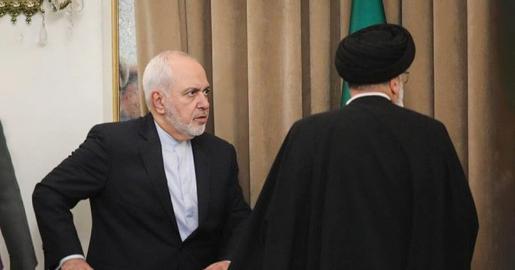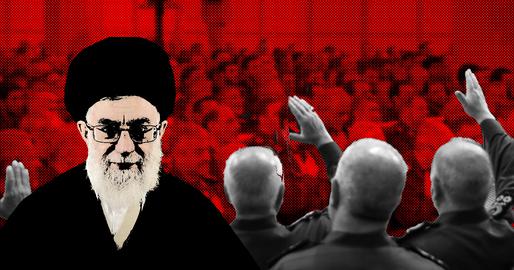Saeed Haddadian is “eulogist” or religious singer, a profession almost unknown outside Iran’s Shiite culture. Eulogists headline religious ceremonies that mourn the death or martyrdom of Shia saints — occasions that Iranian Muslims mark throughout the year. Some eulogists also have a history of celebrating Iranian soldiers killed in battle, notably during the 1980-1988 Iran-Iraq war. The faithful regard famous eulogists with the same adulation that western fans accord to pop stars. Some eulogists try to turn their popularity into political influence, and Haddadian is a striking example.
In early January, Haddadian visited a Syrian battleground for a photo op, and took pictures of himself and his son in military fatigues. When the pictures found their way onto social media, he denied they were meant for publication. But on February 3, Iran’s Tasnim News Agency, which is semi-official and linked to Iran’s powerful Islamic Revolutionary Guards Corps, published two of the photographs alongside a long interview with Haddadian. Haddadian expressed approval of Iran’s military role in Syria and said, “In fighting the terrorists, we are definitely close to victory, and everybody knows it.”
In recent years, Haddadian has become one of the most controversial eulogists in Iran. He once supported former President Mahmoud Ahmadinejad, but in 2011, as conflict arose between Ahmadinejad and Supreme Leader Ali Khamenei, he joined Ahmadinejad’s conservative opponents. He now engages in cultural activities with the supreme leader’s office, and enjoys good relations with Deputy Parliament Speaker Mohammad-Hossein Abu-Torabi. A few months ago, Haddadian announced that eulogists might present their own list of candidates for upcoming parliamentary elections.
Speaking to Tasnim about Iranian fighters in Syria, he said, “Someone came to me and said he belonged to the Western Fighters, someone said that he belonged to the Eastern Fighters, and someone said that he was a member of so-and-so’s congregation. Look, we are them and they are us.” The so-called “Western Fighters” and “Eastern Fighters” belong to hundreds of Iranian religious groups that are active in Syria under the umbrella of the “Congregation of Islamic Fighters” — a body that organized religious ceremonies for soldiers during the Iran-Iraq war. Figures such as Hossein Taeb, the head of the Revolutionary Guards’ Intelligence Unit, Ahmad Khatami, the ultra-fundamentalist member of Assembly of Experts’ board of directors, and Alireza Panahian, a hardliner preacher, have all been members of the organization’s governing council.
Tasnim has also published a video of Haddadian singing eulogies for an audience of Iranian soldiers in an area close to Aleppo on January 26. The soldiers, aware of his fame, sing along enthusiastically.
Defenders of the Shrine
Haddadian told Tasnim that he began his efforts to visit Syria in early January. Iranian media first published news and pictures of his visit under the headline, “Haddad Joins the Defenders of the Shrine.” The headline refers to the shrine of Zainab, daughter of the first Shia imam Ali, which is in Damascus. “Defenders of the Shrine” are fighters Iran has sent to Syria to support the government of President Bashar al-Assad.
On January 26, Mohsen Kazemini, commander of Tehran’s Revolutionary Guards, announced that the offices of Basij paramilitary forces in Greater Tehran would register volunteers who wanted to go to Syria as military “advisors.”
Haddadian claimed that he and his son visited a battlefield position only 500 meters from enemy forces. Many on social media argued his photos were staged.
Haddadian’s visit might have gone unnoticed by the outside world, except that in late January, Saudi Arabian media reported that he and his son had been killed in Syria. Haddadian denied the report to the Fars News Agency, which is affiliated with Iran’s Revolutionary Guards. Haddadian told Fars he had visited Syria to gather material for an event at Tehran University devoted to the Defenders of the Shrine.
The Afghan “Volunteers”
Haddadian also complained that after his return, people he claimed were under the influence of hostile Western media were saying Iran was paying Afghans to fight in Syria. “It was very painful for me to hear this,” he said, “because the dedication I saw among the Afghans was unprecedented.”
There have been many reports in recent years about Iran dispatching Afghans to Syria. In 2014, the Wall Street Journal reported that Iran was paying Afghan refugees $500 per month to fight, and offering them residency permits upon their return.
According to a report by the international non-governmental organization Human Rights Watch, “Iran’s Revolutionary Guards Corps (IRGC) has recruited thousands of undocumented Afghans living there to fight in Syria since at least November 2013.”
The report went on to say that some Afghans had reported that Iranian authorities coerced them. “Iran has urged the Afghans to defend Shia sacred sites and offered financial incentives and legal residence in Iran to encourage them to join pro-Syrian government militias [...] One 17-year-old said he had been forced to fight without being given the opportunity to refuse. Others said they had volunteered to fight in Syria in Iranian-organized militias, either out of religious conviction or to regularize their residence status in Iran.”
Haddadian summarized his experience in Syria by saying that everybody had asked him to convey greetings and respect to the supreme leader.
Haddadian was not the first Iranian eulogist to visit Syria, although he was the biggest news-maker.
The aim of pro-government eulogists, it seems, is to create a parallel between Iran’s military activities in Syria and the “Sacred Defense” of Iran during the Iran-Iraq war. It remains to be seen whether Iranians will accept the analogy.
Related articles:
Outspoken Guards Commander Killed in Syria
Cooperation by Stealth: Iran’s Airstrikes against the Islamic State
visit the accountability section
In this section of Iran Wire, you can contact the officials and launch your campaign for various problems



























comments